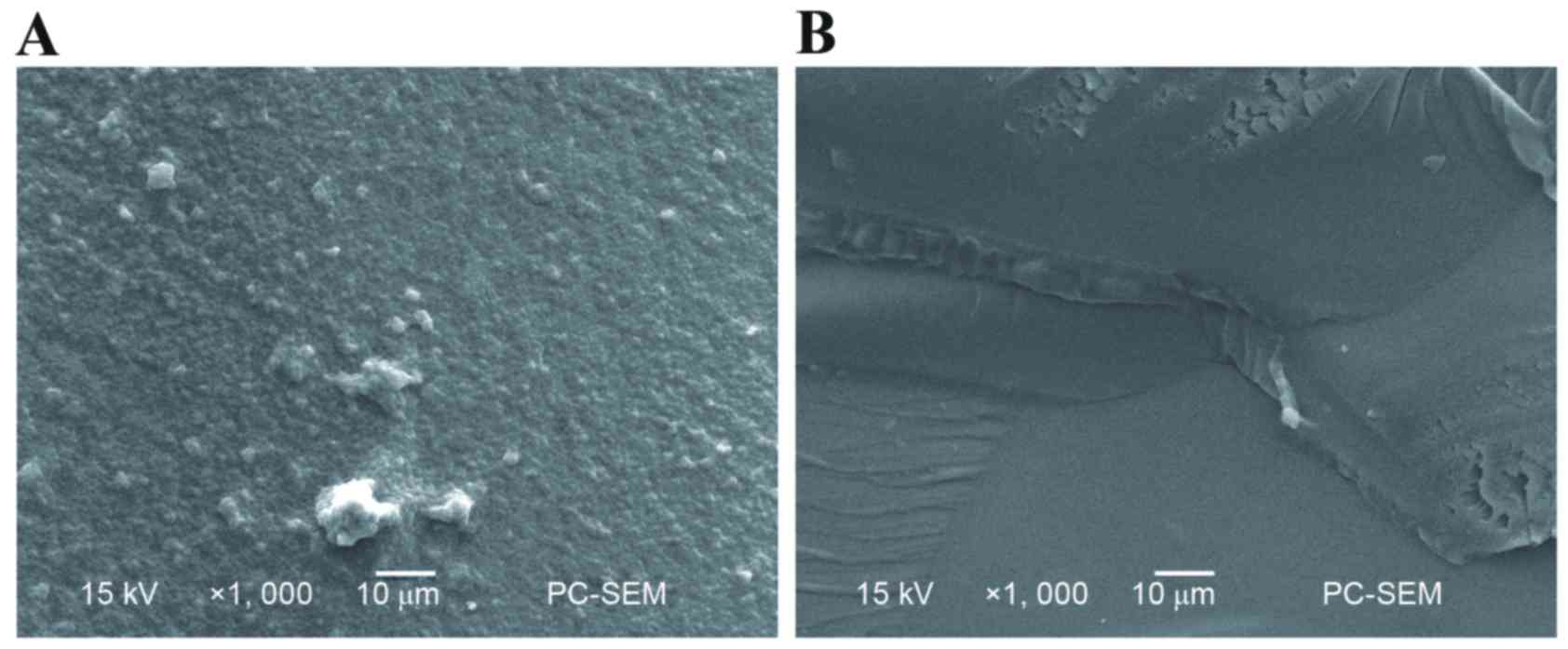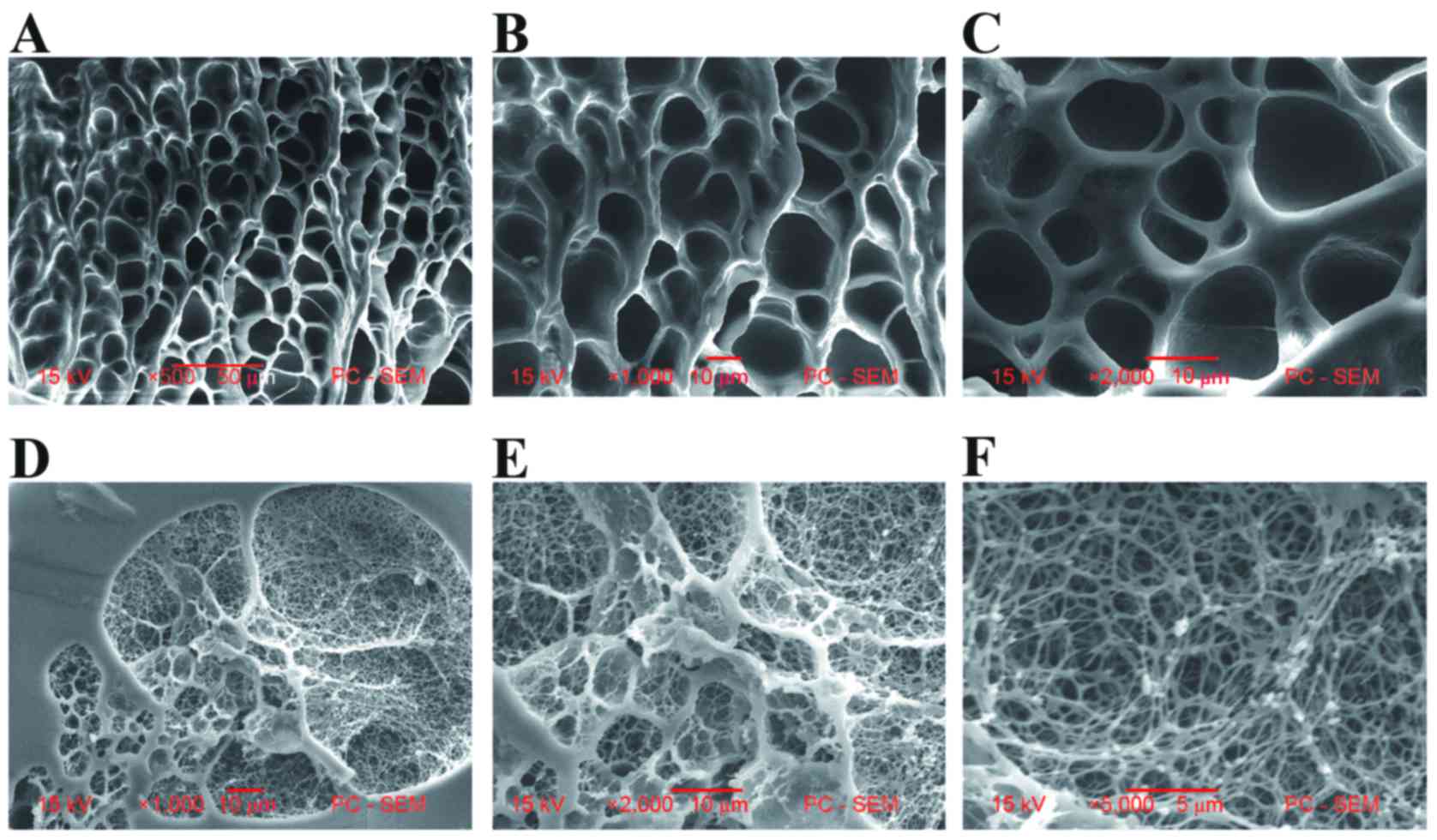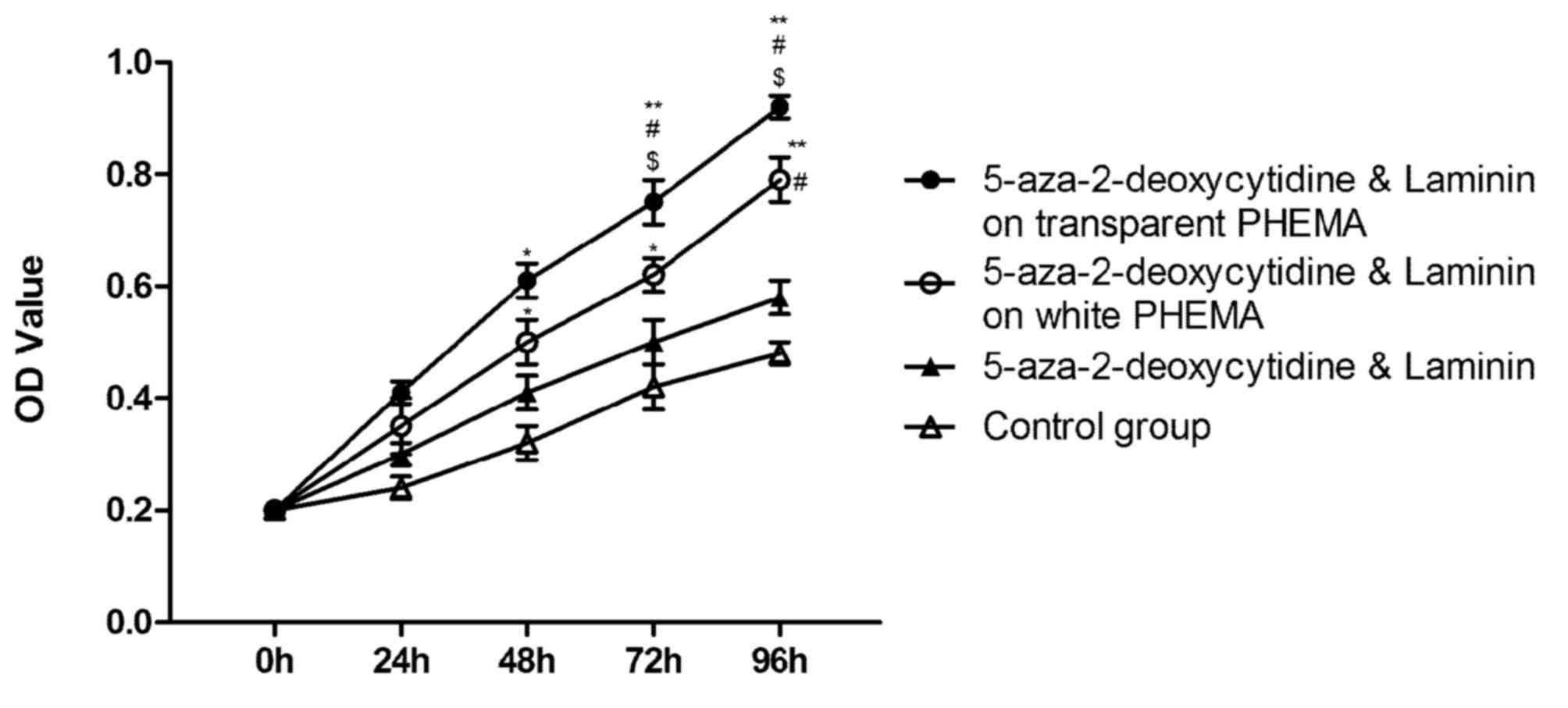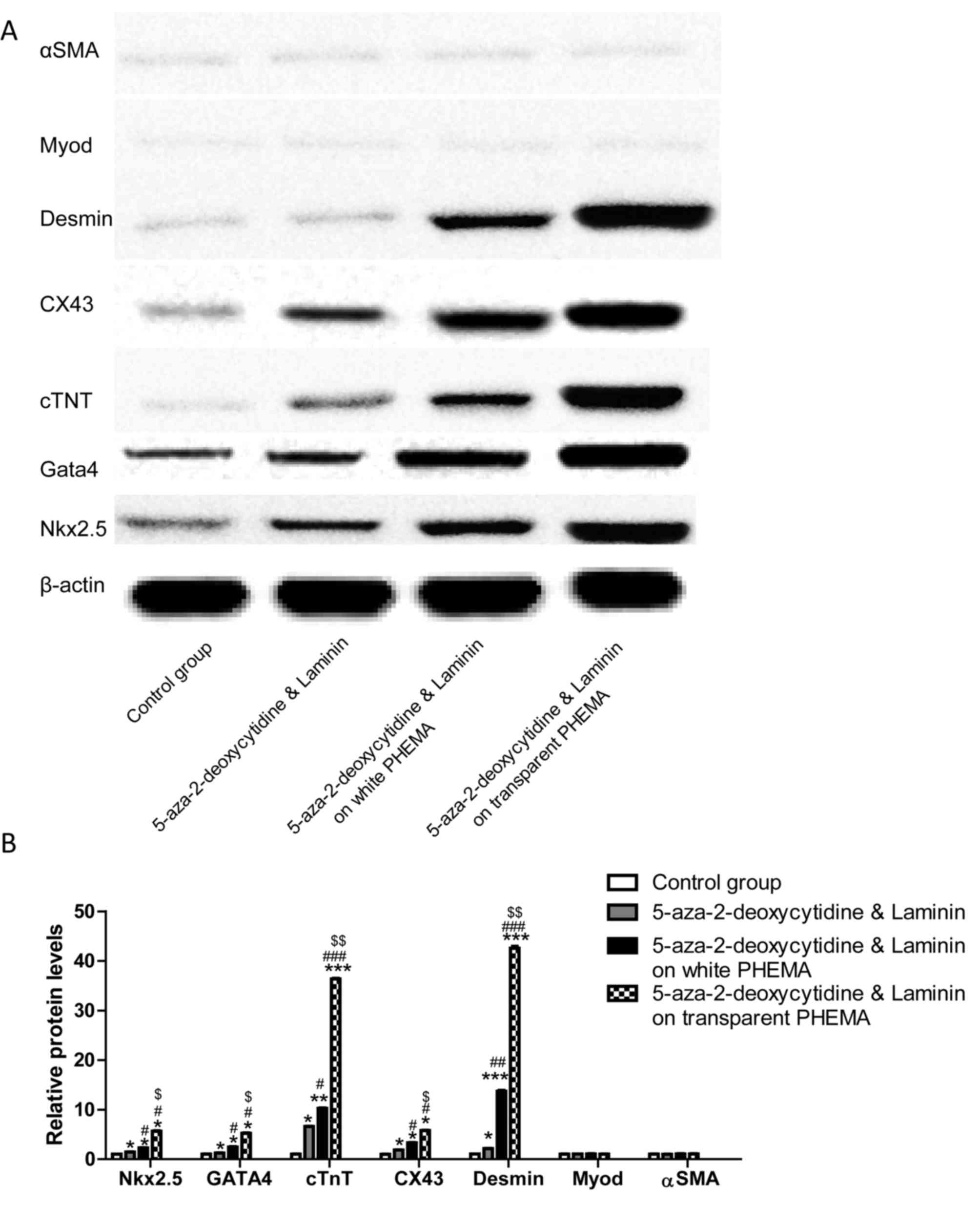|
1
|
LaPar DJ, Kron IL and Yang Z: Stem cell
therapy for ischemic heart disease: Where are we? Curr Opin Organ
Transplant. 14:79–84. 2009. View Article : Google Scholar : PubMed/NCBI
|
|
2
|
Chang TI, Shilane D, Kazi DS, Montez-Rath
ME, Hlatky MA and Winkelmayer WC: Multivessel coronary artery
bypass grafting versus percutaneous coronary intervention in ESRD.
J Am Soc Nephrol. 23:2042–2049. 2012. View Article : Google Scholar : PubMed/NCBI
|
|
3
|
Abdallah MS, Wang K, Magnuson EA, Spertus
JA, Farkouh ME, Fuster V and Cohen DJ: FREEDOM Trial Investigators:
Quality of life after PCI vs CABG among patients with diabetes and
multivessel coronary artery disease: A randomized clinical trial.
JAMA. 310:1581–1590. 2013. View Article : Google Scholar : PubMed/NCBI
|
|
4
|
Zuk PA, Zhu M, Mizuno H, Huang J, Futrell
JW, Katz AJ, Benhaim P, Lorenz HP and Hedrick MH: Multilineage
cells from human adipose tissue: Implications for cell-based
therapies. Tissue Eng. 7:211–228. 2001. View Article : Google Scholar : PubMed/NCBI
|
|
5
|
Miyahara Y, Nagaya N, Kataoka M, Yanagawa
B, Tanaka K, Hao H, Ishino K, Ishida H, Shimizu T, Kangawa K, et
al: Monolayered mesenchymal stem cells repair scarred myocardium
after myocardial infarction. Nat Med. 12:459–465. 2006. View Article : Google Scholar : PubMed/NCBI
|
|
6
|
Planat-Bénard V, Menard C, André M, Puceat
M, Perez A, Garcia-Verdugo JM, Pénicaud L and Casteilla L:
Spontaneous cardiomyocyte differentiation from adipose tissue
stroma cells. Circ Res. 94:223–229. 2004. View Article : Google Scholar : PubMed/NCBI
|
|
7
|
McIntosh K, Zvonic S, Garrett S, Mitchell
JB, Floyd ZE, Hammill L, Kloster A, Di Halvorsen Y, Ting JP, Storms
RW, et al: The immunogenicity of human adipose-derived cells:
Temporal changes in vitro. Stem Cells. 24:1246–1253. 2006.
View Article : Google Scholar : PubMed/NCBI
|
|
8
|
Puissant B, Barreau C, Bourin P, Clavel C,
Corre J, Bousquet C, Taureau C, Cousin B, Abbal M, Laharrague P, et
al: Immunomodulatory effect of human adipose tissue-derived adult
stem cells: Comparison with bone marrow mesenchymal stem cells. Br
J Haematol. 129:118–129. 2005. View Article : Google Scholar : PubMed/NCBI
|
|
9
|
Laflamme MA and Murry CE: Heart
regeneration. Nature. 473:326–335. 2011. View Article : Google Scholar : PubMed/NCBI
|
|
10
|
Singh D, Nayak V and Kumar A:
Proliferation of myoblast skeletal cells on three-dimensional
supermacroporous cryogels. Int J Biol Sci. 6:371–381. 2010.
View Article : Google Scholar : PubMed/NCBI
|
|
11
|
Jin J, Jeong SI, Shin YM, Lim KS, Shin HS,
Lee YM, Koh HC and Kim KS: Transplantation of mesenchymal stem
cells within a poly(lactide-co-epsilon-caprolactone) scaffold
improves cardiac function in a rat myocardial infarction model. Eur
J Heart Fail. 11:147–153. 2009. View Article : Google Scholar : PubMed/NCBI
|
|
12
|
Akhyari P, Kamiya H, Haverich A, Karck M
and Lichtenberg A: Myocardial tissue engineering: The extracellular
matrix. Eur J Cardiothorac Surg. 34:229–241. 2008. View Article : Google Scholar : PubMed/NCBI
|
|
13
|
Novakovic Vunjak G, Eschenhagen T and
Mummery C: Myocardial tissue engineering: In vitro models. Cold
Spring Harb Perspect Med. 4:pii: a014076. 2014.
|
|
14
|
Kim Y, Ko H, Kwon IK and Shin K:
Extracellular matrix revisited: Roles in tissue engineering. Int
Neurourol J. 20:(Suppl 1). S23–S29. 2016. View Article : Google Scholar : PubMed/NCBI
|
|
15
|
Lou X, Munro S and Wang S: Drug release
characteristics of phase separation pHEMA sponge materials.
Biomaterials. 25:5071–5080. 2004. View Article : Google Scholar : PubMed/NCBI
|
|
16
|
Panfilov IA, de Jong R, Takashima S and
Duckers HJ: Clinical study using adipose-derived mesenchymal-like
stem cells in acute myocardial infarction and heart failure.
Methods Mol Biol. 1036:207–212. 2013. View Article : Google Scholar : PubMed/NCBI
|
|
17
|
van Dijk A, Niessen HW, Ursem W, Twisk JW,
Visser FC and van Milligen FJ: Accumulation of fibronectin in the
heart after myocardial infarction: A putative stimulator of
adhesion and proliferation of adipose-derived stem cells. Cell
Tissue Res. 332:289–298. 2008. View Article : Google Scholar : PubMed/NCBI
|
|
18
|
Tandon N, Cannizzaro C, Chao PH, Maidhof
R, Marsano A, Au HT, Radisic M and Vunjak-Novakovic G: Electrical
stimulation systems for cardiac tissue engineering. Nat Protoc.
4:155–173. 2009. View Article : Google Scholar : PubMed/NCBI
|
|
19
|
Zimmermann WH: Remuscularizing failing
hearts with tissue engineered myocardium. Antioxid Redox Signal.
11:2011–2023. 2009. View Article : Google Scholar : PubMed/NCBI
|
|
20
|
Dai R, Wang Z, Samanipour R, Koo KI and
Kim K: Adipose-derived stem cells for tissue engineering and
regenerative medicine applications. Stem Cells Int.
2016:67373452016. View Article : Google Scholar : PubMed/NCBI
|
|
21
|
Harrison BS and Atala A: Carbon nanotube
applications for tissue engineering. Biomaterials. 28:344–353.
2007. View Article : Google Scholar : PubMed/NCBI
|
|
22
|
Horák D, Hlídková H, Hradil J, Lapčíková M
and Šlouf M: Superporous poly(2-hydroxyethyl methacrylate) based
scaffolds: Preparation and characterization. Polymer. 49:2046–2054.
2008. View Article : Google Scholar
|
|
23
|
Lutolf MP and Hubbell JA: Synthetic
biomaterials as instructive extracellular microenvironments for
morphogenesis in tissue engineering. Nat Biotechnol. 23:47–55.
2005. View
Article : Google Scholar : PubMed/NCBI
|
|
24
|
Vijayasekaran S, Hicks CR, Chirila TV,
Fitton JH, Clayton AB, Lou X, Platten S, Crawford GJ and Constable
IJ: Histologic evaluation during healing of hydrogel core-and-skirt
keratoprostheses in the rabbit eye. Cornea. 16:352–359. 1997.
View Article : Google Scholar : PubMed/NCBI
|
|
25
|
Atzet S, Curtin S, Trinh P, Bryant S and
Ratner B: Degradable poly(2-hydroxyethyl
methacrylate)-co-polycaprolactone hydrogels for tissue engineering
scaffolds. Biomacromolecules. 9:3370–3377. 2008. View Article : Google Scholar : PubMed/NCBI
|
|
26
|
Kopeček J: Hydrogels from soft contact
lenses and implants to self-assembled nanomaterials. J Polym Sci A
Polym Chem. 47:5929–5946. 2009. View Article : Google Scholar : PubMed/NCBI
|
|
27
|
Chirila TV: An overview of the development
of artificial corneas with porous skirts and the use of PHEMA for
such an application. Biomaterials. 22:3311–3317. 2001. View Article : Google Scholar : PubMed/NCBI
|
|
28
|
Castner DG and Ratner BD: Biomedical
surface science: Foundations to frontiers. Surface Sci. 500:28–60.
2002. View Article : Google Scholar
|
|
29
|
Lee KY and Mooney DJ: Hydrogels for tissue
engineering. Chem Rev. 101:1869–1879. 2001. View Article : Google Scholar : PubMed/NCBI
|
|
30
|
Refojo MF: Hydrophobic interaction in
poly(2-hydroxyethyl methacrylate) homogeneous hydrogel. J Polym Sci
A1. 5:3103–3113. 1967. View Article : Google Scholar : PubMed/NCBI
|
|
31
|
Rosiak JM and Yoshii F: Hydrogels and
their medical applications. Nuclear Instruments Methods Physics Res
Section B: Beam Interactions Materials Atoms. 151:56–64. 1999.
View Article : Google Scholar
|
|
32
|
Poncin-Epaillard F, Vrlinic T, Debarnot D,
Mozetic M, Coudreuse A, Legeay G, El Moualij B and Zorzi W: Surface
treatment of polymeric materials controlling the adhesion of
biomolecules. J Funct Biomater. 3:528–543. 2012. View Article : Google Scholar : PubMed/NCBI
|
|
33
|
Thevenot P, Hu W and Tang L: Surface
chemistry influence implant biocompatibility. Curr Top Med Chem.
8:270–280. 2008. View Article : Google Scholar : PubMed/NCBI
|
|
34
|
Schäffler A and Büchler C: Concise review:
Adipose tissue-derived stromal cells-basic and clinical
implications for novel cell-based therapies. Stem Cells.
25:818–827. 2007. View Article : Google Scholar : PubMed/NCBI
|
|
35
|
Bai X, Pinkernell K, Song YH, Nabzdyk C,
Reiser J and Alt E: Genetically selected stem cells from human
adipose tissue express cardiac markers. Biochem Biophys Res Commun.
353:665–671. 2007. View Article : Google Scholar : PubMed/NCBI
|
|
36
|
Rangappa S, Fen C, Lee EH, Bongso A and
Sim EK: Transformation of adult mesenchymal stem cells isolated
from the fatty tissue into cardiomyocytes. Ann Thorac Surg.
75:775–779. 2003. View Article : Google Scholar : PubMed/NCBI
|
|
37
|
Zhang DZ, Gai LY, Liu HW, Jin QH, Huang JH
and Zhu XY: Transplantation of autologous adipose-derived stem
cells ameliorates cardiac function in rabbits with myocardial
infarction. Chin Med J (Engl). 120:300–307. 2007.PubMed/NCBI
|
|
38
|
Burlacu A: Can 5-azacytidine convert the
adult stem cells into cardiomyocytes? A brief overview. Arch
Physiol Biochem. 112:260–264. 2006. View Article : Google Scholar : PubMed/NCBI
|
|
39
|
Christman KL, Fok HH, Sievers RE, Fang Q
and Lee RJ: Fibrin glue alone and skeletal myoblasts in a fibrin
scaffold preserve cardiac function after myocardial infarction.
Tissue Eng. 10:403–409. 2004. View Article : Google Scholar : PubMed/NCBI
|
|
40
|
Chastain SR, Kundu AK, Dhar S, Calvert JW
and Putnam AJ: Adhesion of mesenchymal stem cells to polymer
scaffolds occurs via distinct ECM ligands and controls their
osteogenic differentiation. J Biomed Mater Res A. 78:73–85. 2006.
View Article : Google Scholar : PubMed/NCBI
|
|
41
|
Malek S, Kaplan E, Wang JF, Ke Q, Rana JS,
Chen Y, Rahim BG, Li M, Huang Q, Xiao YF, et al: Successful
implantation of intravenously administered stem cells correlates
with severity of inflammation in murine myocarditis. Pflugers Arch.
452:268–275. 2006. View Article : Google Scholar : PubMed/NCBI
|
|
42
|
French KM, Maxwell JT, Bhutani S,
Ghosh-Choudhary S, Fierro MJ, Johnson TD, Christman KL, Taylor WR
and Davis ME: Fibronectin and cyclic strain improve cardiac
progenitor cell regenerative potential in vitro. Stem Cells Int.
2016:83643822016. View Article : Google Scholar : PubMed/NCBI
|
|
43
|
Shi S, Wu X, Wang X, Hao W, Miao H, Zhen L
and Nie S: Differentiation of bone marrow mesenchymal stem cells to
cardiomyocyte-like cells is regulated by the combined low dose
treatment of transforming growth factor-β1 and 5-azacytidine. Stem
Cells Int. 2016:38162562016. View Article : Google Scholar : PubMed/NCBI
|
|
44
|
Kado M, Lee JK, Hidaka K, Miwa K, Murohara
T, Kasai K, Saga S, Morisaki T, Ueda Y and Kodama I: Paracrine
factors of vascular endothelial cells facilitate cardiomyocyte
differentiation of mouse embryonic stem cells. Biochem Biophys Res
Commun. 377:413–418. 2008. View Article : Google Scholar : PubMed/NCBI
|
|
45
|
Gassanov N, Devost D, Danalache B, Noiseux
N, Jankowski M, Zingg HH and Gutkowska J: Functional activity of
the carboxyl-terminally extended oxytocin precursor Peptide during
cardiac differentiation of embryonic stem cells. Stem Cells.
26:45–54. 2008. View Article : Google Scholar : PubMed/NCBI
|
|
46
|
Kasahara H, Bartunkova S, Schinke M,
Tanaka M and Izumo S: Cardiac and extracardiac expression of
Csx/Nkx2.5 homeodomain protein. Circ Res. 82:936–946. 1998.
View Article : Google Scholar : PubMed/NCBI
|
|
47
|
Xu C, Police S, Rao N and Carpenter MK:
Characterization and enrichment of cardiomyocytes derived from
human embryonic stem cells. Circ Res. 91:501–508. 2002. View Article : Google Scholar : PubMed/NCBI
|
|
48
|
Gaustad KG, Boquest AC, Anderson BE,
Gerdes AM and Collas P: Differentiation of human adipose tissue
stem cells using extracts of rat cardiomyocytes. Biochem Biophys
Res Commun. 314:420–427. 2004. View Article : Google Scholar : PubMed/NCBI
|
|
49
|
Bloor DJ, Wilson Y, Kibschull M, Traub O,
Leese HJ, Winterhager E and Kimber SJ: Expression of connexins in
human preimplantation embryos in vitro. Reprod Biol Endocrinol.
2:252004. View Article : Google Scholar : PubMed/NCBI
|
|
50
|
Souders CA, Bowers SL and Baudino TA:
Cardiac fibroblast: The renaissance cell. Circ Res. 105:1164–1176.
2009. View Article : Google Scholar : PubMed/NCBI
|
|
51
|
Szaraz P, Librach M, Maghen L, Iqbal F,
Barretto TA, Kenigsberg S, Gauthier-Fisher A and Librach CL: In
vitro differentiation of first trimester human umbilical cord
perivascular cells into contracting cardiomyocyte-like cells. Stem
Cells Int. 2016:75132522016. View Article : Google Scholar : PubMed/NCBI
|
|
52
|
Schulz R and Heusch G: Connexin 43 and
ischemic preconditioning. Cardiovasc Res. 62:335–344. 2004.
View Article : Google Scholar : PubMed/NCBI
|
|
53
|
Thomas SA, Schuessler RB, Berul CI,
Beardslee MA, Beyer EC, Mendelsohn ME and Saffitz JE: Disparate
effects of deficient expression of connexin43 on atrial and
ventricular conduction: Evidence for chamber-specific molecular
determinants of conduction. Circulation. 97:686–691. 1998.
View Article : Google Scholar : PubMed/NCBI
|













